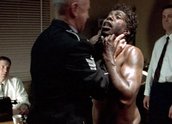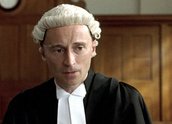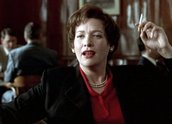


Black and White (2002)
Synopsis
Max Stuart (David Ngoombujarra), a 27-year-old mixed-race Aborigine from Alice Springs, is arrested in December 1958 in Ceduna, on the South Australian border. He is charged with the rape and murder of a nine-year-old girl, Mary Hattam, whose body was found in a cave at Ceduna Beach. His footprints on the beach are identified by two Aboriginal trackers and he signs a confession. Adelaide solicitor JD (David) O’Sullivan (Robert Carlyle) is assigned to defend him, an inexperienced lawyer up against a well-connected Crown prosecutor, Roderic Chamberlain (Charles Dance). O’Sullivan quickly establishes that his client can neither read nor write, and alleges in court that the police beat the confession out of him. Stuart is found guilty by a jury and a judge sentences him to death.
O’Sullivan appeals to the South Australian Supreme Court, against the advice of his more practical legal partner, Helen Devaney (Kerry Fox). Stuart’s appeal fails, partly because of O’Sullivan’s poor defence. The young owner of the Adelaide News newspaper, Rupert Murdoch (Ben Mendelsohn), decides to start a campaign to save 'an innocent man’ from the gallows. With the help of a sympathetic priest, Father Dixon (Colin Friels), and donations from the public, O’Sullivan appeals to the Privy Council in London, where he fails spectacularly to make his case. In Adelaide, the state government announces a royal commission, in order to stem the rising tide of public opinion. After his seventh nerve-racking stay of execution, the government commutes Stuart’s sentence, although the royal commission finds that his conviction was justified and should not be quashed. Max Stuart eventually serves 14 years in prison.
Curator’s notes
The Max Stuart case remains a controversial subject, partly because Stuart’s innocence has never been proved. Some of those involved at the time still believe he was guilty. The film attempts to encompass this ambiguity and shift the focus away from whether he was guilty to the question of whether he got a fair trial. It does this by presenting two versions of what might have happened, the defence’s point of view and the prosecution’s point of view, so that there is no easy path to the truth. Rather, the film makes a strong case that there was an injustice, born out of racism, regardless of whether he committed the crime.
It’s also a study of the way power works within a society and the role of the media. There are careers at stake in the Stuart case – not just the Crown prosecutor, who wants to be the next Chief Justice of South Australia, and not just Dave O’Sullivan, who wants to take down the upper class, born-to-rule lawyers of Adelaide. There is also the ambition of Dave’s partner Helen – who wants to cut Max Stuart adrift and save their legal firm from bankruptcy – and the ambitious young newspaper proprietor Rupert Murdoch and his editor Rohan Rivett, who aim to rattle the South Australian Establishment.
Professor Ken Inglis, who wrote one of the four books on the case and is one of Australia’s most distinguished historians, has written about the film as follows: 'Black and White invites us to form our own judgement on whether Stuart committed the crime, offering two contradictory versions of events, which happen also to represent the conflicting opinion of the filmmakers. The author of the screenplay, Louis Nowra, concluded that Stuart was guilty. The producer Helen Leake and the director Craig Lahiff believed that he should not have been convicted on the evidence adduced against him in court.’ Inglis believes that the Max Stuart case had major ramifications. 'His case helped to bring down the government of South Australia, to end capital punishment in that State and in the rest of the nation, and to initiate changes in the legal system as it affects Indigenous defendants.’
David Bowman, who went on to become Editor-in-Chief of The Sydney Morning Herald, argues that it was Rohan Rivett, the editor of the Adelaide News, who instigated and led the campaign to save Max Stuart, rather than Rupert Murdoch. The film also fails to mention Stuart’s earlier conviction in Cloncurry, Queensland, of an indecent assault on a nine-year-old girl, which the prosecution was not allowed to raise in court.
Max Stuart was eventually released on parole in late 1973. He became an Elder of the Arrernte people in central Australia and Chairman of the Central Land Council from 1998 to 2001. His story is also told in Blood Brothers – Broken English (1993).
Black and White was released in Australian cinemas on 31 October 2002 and in the UK on 9 January 2003. It was the opening night film at the 2002 Sydney Film Festival and screened at a number of international film festivals including London, Toronto, Pusan and Karlovy Vary. David Ngoombujarra received the award for Best Supporting Actor at the 2003 AFI Awards, and Annie Marshall’s work was nominated for Best Costume Design.
Secondary curator’s notes
by Liz McNivenBlack and White covers the prosecution of Max Rupert Stuart for the alleged murder of a young girl in Ceduna in 1958. Stuart, an Aboriginal man from Alice Springs, faced an all-white jury and was sentenced to hang for the crime.
Stuart claimed police assaulted him and threatened to slit his throat with a razor blade if he didn’t sign a statement of confession, which was written and composed by a police officer. The prosecution based their case against Stuart on this confession. Against the odds, and supported by Catholic priest Tom Dixon and anthropologist Dr Strehlow, lawyer David O’Sullivan and his reluctant partner, Helen Devaney, challenge this injustice. Dr Strehlow, an Arrernte specialist, describes to the High Court of Australia why the confession could not be attributed to Stuart. He identifies the incompatibility of the language structure in Stuart’s confession with that of the Arrernte-English spoken by Stuart and his peoples in Central Australia.
On losing the High Court appeal, O’Sullivan appeals to the Privy Council in London, which finds no reasonable grounds for appeal. The Privy Council scene retraces the threats of white Australian power and privilege, and in doing so belittles both O’Sullivan and Devaney. The film shows the weaknesses in these two characters including Devaney’s underlying racism and drinking issues and O’Sullivan’s professional egotism. Intoxicated by the prestige of appearing before the Privy Council, O’Sullivan concedes his failure to mount a successful argument.
The ignorance and shortcomings of O’Sullivan and Devaney pale by comparison to the lust for power and control exerted by the white male, upper-class pillars of South Australian society. The Crown prosecutor, Roderic Chamberlain, embodies these status-conscious attributes in his arrogant sense of racial, social, cultural and professional superiority. With his ambitions resting on his ability to display legal clout, skill and superiority, Chamberlain struggles to fend off his weaker opponent, O’Sullivan, and the might of media scrutiny from Rupert Murdoch’s Adelaide News. Even Chamberlain’s wife questions the case against Stuart. After a royal commission is called, Justice Abbott tells Chamberlain at the old boys’ club, ‘You see the world in black and white. When are you going to see that there are some shades of grey?’.
Max Stuart didn’t hang but spent 14 years in prison for the murder of the child. The film ends with a clip of Stuart at the time of making the film. As he drives along a red dirt road in central Australia he states, ‘Some people think I am innocent, some people think I am guilty; and some people think Elvis is still alive.’
This rather whimsical ending to a very serious film leaves the storyline up in the air, unresolved and incomplete. We needed to hear about the experience from Max Stuart’s eyes, from the Aboriginal perspective. The film presents dynamic and fleshed-out white characters, but Stuart appears to be the subject of the film’s interest rather than a character we get to know. The storyline follows O’Sullivan’s experience of the events rather than Stuart’s, when in fact it’s Stuart’s story.
That said, Black and White moves white Australia in the right direction in its exposure of racism and injustice and its call for equality and freedom. The Max Stuart case marks a turning point in South Australian legal history and provides white Australia with a mirror on their culturally conditioned notion of racial superiority.
- Overview
- Curator’s notes
- Video 3 clips
- Principal credits
- Find a copy
- Make a comment
- Map
- Add your review




